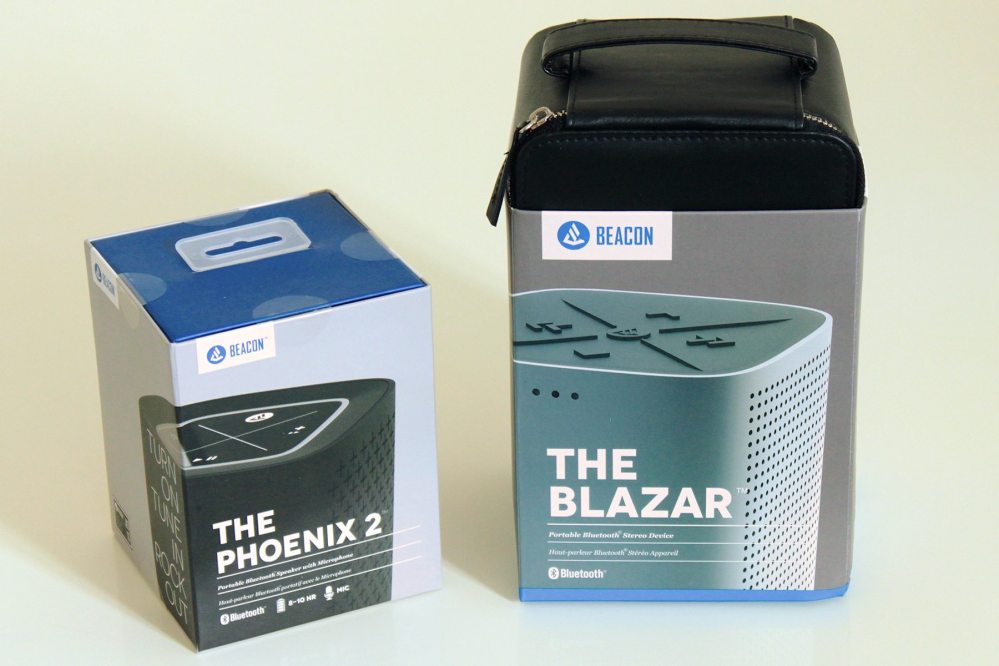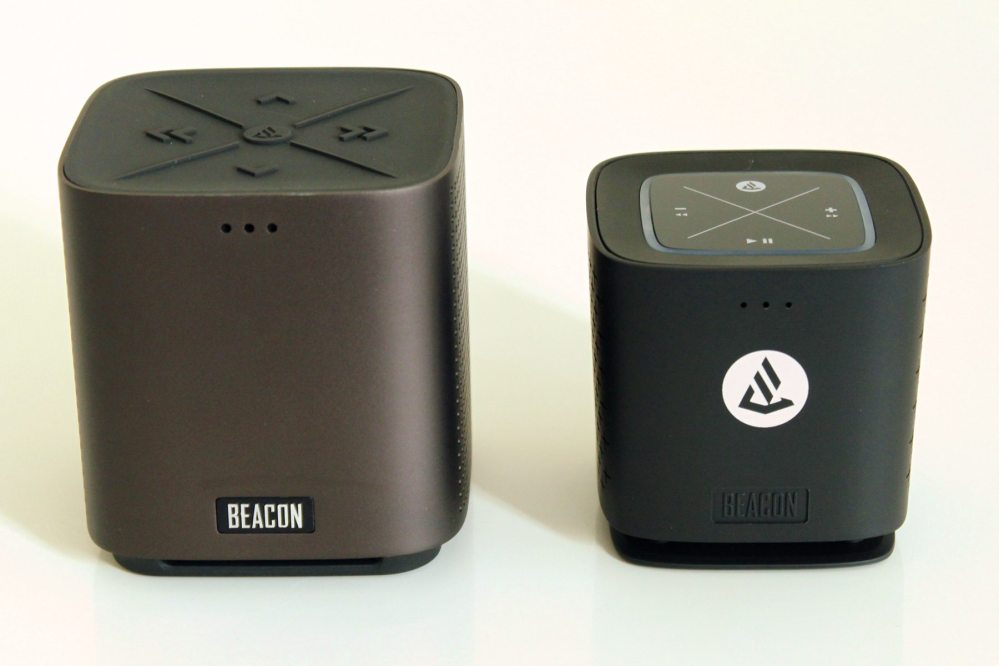
Since having to move out of my home whilst it’s being repaired after the flooding back in February there are many, many things I miss about it. One of them is my proper Hi-Fi — initially we were only expecting to be out for a few months, so I didn’t bother to set it all up at our rental property. It’s not a high-end one like a Sonos or Ryan’s Bluesound system, just a 5.1 system with a good sub and a decent Pioneer amp connected to an Apple TV which streamed my iTunes library and filled the living room. So it’s a big comedown to only have my music coming from the speakers in the iMac whilst I work — which all leads me nicely to The Blazar and The Phoenix 2 from Beacon Audio.
When I received the package, the first thing that struck me about them was the size of the boxes. From the info on the website I was expecting two cubes, one about three inches all around and the other around four, plus obviously a bit more for packaging. However both speakers came in boxes at least double, maybe even triple, the volume of the thing they contain. The packaging itself is very nice — very similar to the quality of Apple’s — but there just seems to be too much of it in an age where other companies are trying to reduce their impact on the environment. Both boxes do have the sizes of the units on the packaging, but I can’t help feeling that you might be a bit disappointed when you open them up if you weren’t aware of that. The Blazar also comes with a seemingly superfluous faux-leather, padded carry case, which might be useful if you could store more than the included micro-USB lead and 3.5mm aux lead in the second compartment.

Once out of the box though, connecting them up is as simple as turning on your device’s Bluetooth and holding the pairing button on the speaker for 10 seconds, then selecting the speaker from the device. The Blazar also has an NFC chip which handles the pairing simply by tapping your phone to the top of the speaker. The controls are very simple, with play/pause, skip/back and volume up/down. Here the smaller Phoenix wins with clear icons and definite up and down orientation. The design of Blazar has a symmetric arrow layout which means it’s not immediately obvious which button does what. The Blazar feels much more solid and weighty as it’s machined from aluminium and is available in both silver and a dark graphite grey. The Phoenix on the other hand is much lighter (less than four ounces) and it’s plastic casing is available in four colours — blue, red, black and white, but still feels sturdy enough to survive being thrown about in a backpack.
Anyway, none of that has anything to do with the most important question about the speakers — how do they sound? In a word, excellent. Both units have twin speakers and a passive radiator bass driver (sub-woofer) — 20 and 30mm respectively for the Phoenix and 50/60mm for the Blazer. The speakers face out sideways which really helps fill the room with sound and gives a much wider stereo effect. And the sub-woofer can deliver those low frequencies with apparent ease — especially on the larger Blazar model, where can can feel the air being pushed out with each boom. I tested them both in my garden and at full volume they were both loud enough to be heard above the noises from the streets, again with the larger Blazar having the edge.

I created a special playlist featuring a wide variety of musical styles from electronic to acoustic to guitar-based to really test how the speakers perform across the frequencies. I probably spent too long on this, but at least I now have an 8 hour selection of some of my favourite tracks! I’ve had it playing all the time I’m writing this review, paying attention to certain parts of certain tracks that I know sound amazing on a big hi-fi to see how they compare.
My favourite go-to track to test the bass response of a speaker has to “Under The Influence” by The Chemical Brothers. It has fantastic swooping bass breakdown that gets lower and lower and then kicks with a thundering bassline to go with the crisp cymbals and synths. Both speakers passed this test, although the smaller Phoenix 2 did start to walk across the desk with the vibrations! Another good one to try out the low end with is “LFO” by LFO, you should be able to feel that Low Frequency Oscillation is your chest! The Blazar was again fine with this one, but the Phoenix was lagging behind a bit and even had a bit of distortion in places.
As I went through the playlist I swapped between the two speakers on each track and they both performed admirably in the mid-range and high-end. Vocals, guitars and cymbals all sound great, even the crazy bleeps and strange noises of the new Aphex Twin album came out fine, but I kept finding the smaller Phoenix to be lacking in the lower frequencies. I’m not saying it doesn’t have any bass to it — indie-pop baselines and deep piano or saxophone riffs are perfectly adequate — and I’m sure it will be fine in smaller spaces or for when you want to travel light, but if you need that whommp, whommp, whommp in your music then you really should go for the larger Blazar.
Internally, both speakers are very similar. Both feature the Bluetooth 2.1 EDR chipset and are compatible with any Bluetooth enabled device with audio-out protocols. Both of them have microphones to enable you to take phone calls through them. Additionally, they both have a regular 3.5mm auxiliary jack (cable included) for anything that doesn’t have Bluetooth.
In addition to playing music from my phone, I also tried out a number of apps, including Traktor DJ and Djay 2 both of which performed perfectly over the wireless connection. There was no noticeable latency when cueing up tracks and messing around with effects. It does mean that you can’t use the split output pre-cue option with them, but that’s where the line-in comes in handy. Never has been easier to hold your own mini-rave in the middle of a field!
I also tried out some synth and drum machine apps, but this time there did seem to be a small amount of latency — maybe only 200ms — which is enough to make them hard to use. This isn’t down to the speakers themselves — it’s more to do with Bluetooth and the device’s internal master clock — but again, the line-in comes to the rescue.

The Blazar has an extra neat bit of functionality that comes into play if you have two of them. Once disconnected from any Bluetooth devices, they can be connected together to form a proper dual-stereo set up, with one connecting to the Bluetooth device and other acting like a slave, but with proper left and right channels up to 40 feet apart, and with double the volume. Unusually too, the Blazar has a 3.5mm auxiliary OUT port, which enables you use the speaker as a Bluetooth receiver for your stereo plug or to plug headphones in to for a sort of wireless headphone experience — sitting out in the garden listening to to tunes from your computer in privacy maybe? I’ve taken to connecting the aux-out of the Blazar to the aux-in of the Phoenix to kind of recreate the dual-stereo effect, but without the proper left and right channels.
Beacon Audio claim about a 35 foot range for the Bluetooth signal and I’d agree with that, both speakers were fine for the useable length of my small back garden, only dropping the signal a bit when I went behind the shed. Battery life is good too, 8-10 hours for the Phoenix and 10-12 for the Blazar. I’ve had them going all day long through my playlist and they’re still going strong and it’s simple enough to recharge them with the micro-USB lead included in the box.
Both speakers are available online from places like Amazon or direct from the Beacon Audio website, the Phoenix 2 for $80 and the Blazar for $150 (or a pair for $280), and they come with both a 30 day “Sounds Great” guarantee (so you can get your money back if you’re not happy with the sound quality) and a 1000 day warranty against defects.
Many thanks to Beacon Audio for suppling us with the review units.



